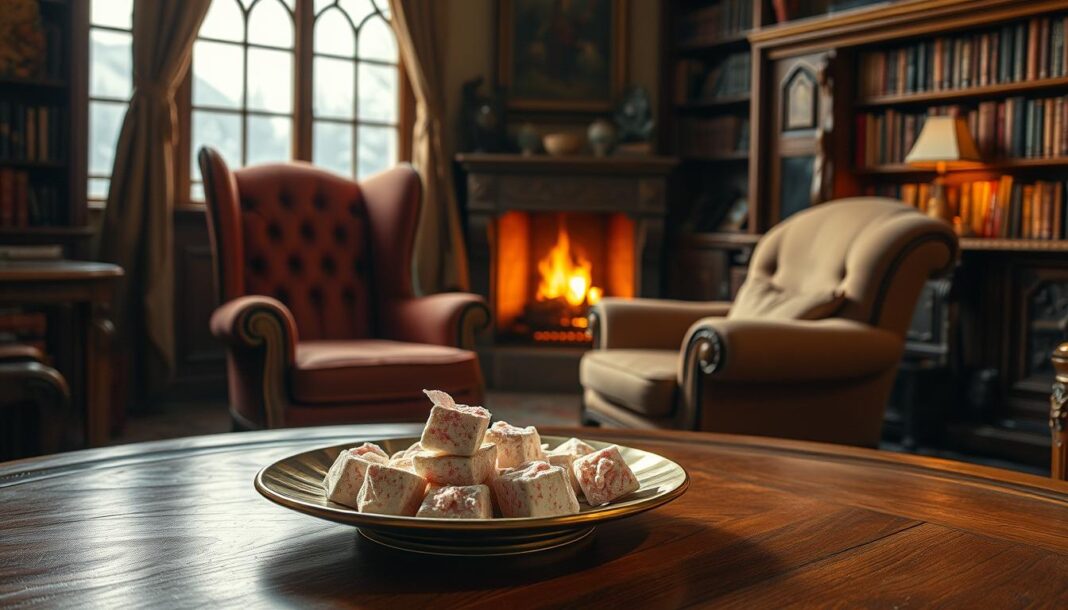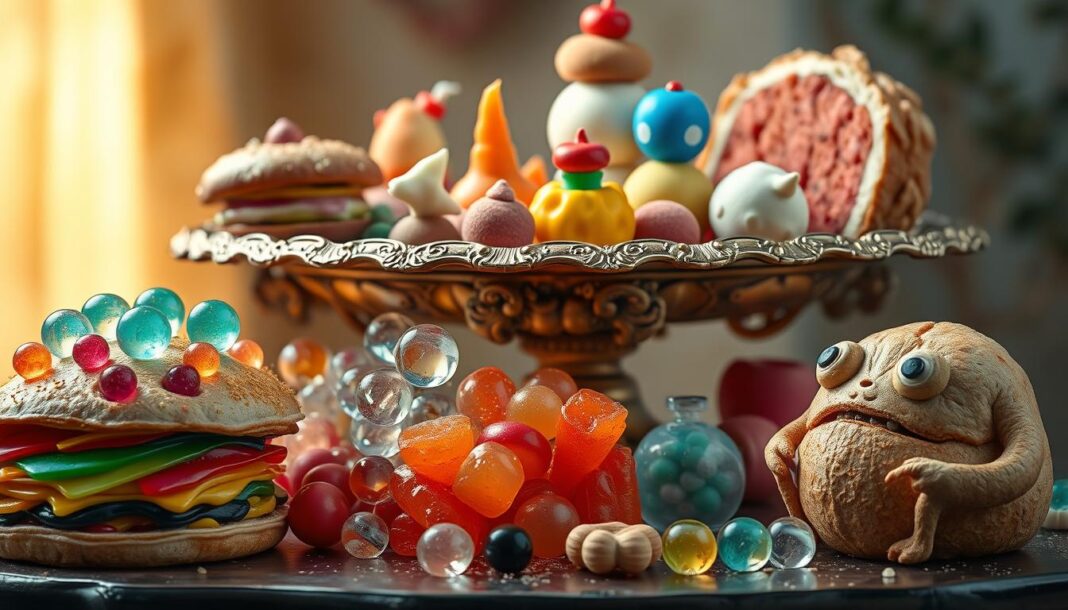In C.S. Lewis’s timeless classic, The Lion, the Witch, and the Wardrobe, Turkish Delight plays a pivotal role in tempting Edmund Pevensie into betraying his siblings. This enchanted confection has captivated readers’ imaginations since the book’s publication in 1950.
We will explore the literary significance of Turkish Delight in Narnia, examining its representation of temptation, desire, and the consequences of giving in to one’s weaknesses. Turkish Delight, or Lokum, is a sweet treat made with starch and powdered sugar, often flavored with rosewater or lemon. As we delve into the world of Narnia, we will also uncover the real-world origins of this iconic confection and provide an authentic recipe to recreate it at home.
Key Takeaways
- Turkish Delight is a significant element in The Lion, the Witch, and the Wardrobe, symbolizing temptation and desire.
- The confection has a rich history and cultural significance beyond its literary representation.
- We will explore the real-world origins of Turkish Delight and its ingredients.
- An authentic recipe will be provided to recreate Turkish Delight at home.
- The Chronicles of Narnia continue to captivate audiences with its rich and imaginative world-building.
The Magical Allure of Turkish Delight in Narnia
Turkish Delight, a seemingly innocent confection, becomes a powerful symbol of temptation in The Chronicles of Narnia. In C.S. Lewis’s masterful storytelling, this sweet treat plays a crucial role in Edmund’s betrayal, illustrating the dangers of succumbing to temptation.
Edmund’s Temptation by the White Witch
The White Witch’s use of Turkish Delight as a tool for manipulation is a significant element in Narnia’s narrative. She tempts Edmund with a box of enchanted lokum, creating an insatiable craving that clouds his judgment.
Why Turkish Delight Was the Perfect Enchanted Treat
Turkish Delight was chosen for its exotic nature in post-war Britain. The powdery, soft texture and intense sweetness make it the perfect metaphor for temptation.
| Characteristics | White Witch’s Turkish Delight | Regular Turkish Delight |
|---|---|---|
| Addictive Properties | Highly addictive due to magical elements | Not addictive |
| Taste and Texture | Powdery, soft, intensely sweet | Varied flavors and textures |
| Effect on Consumer | Creates insatiable craving, clouds judgment | Satisfies sweet tooth, no adverse effects on judgment |
| Symbolism in Narnia | Represents temptation and betrayal | Represents a traditional sweet treat |

What is Turkish Delight? A Sweet History
The sweet and intriguing history of Turkish Delight is a story worth exploring, from its Turkish origins to its global popularity. We delve into the fascinating world of this confectionery treat, known locally as “Lokum.”
Origins in Turkey: The Story of Lokum
Turkish Delight, or Lokum, has its roots in 18th-century Turkey. The name “Lokum” is derived from the Arabic words “luqma(t)” meaning morsel, and “luqūm” meaning mouthful. Bekir Effendi, a confectioner, is credited with inventing the sweet as we know it today when he opened his shop in Istanbul in 1776. Made from a gel created by heating sugar and starch, Turkish Delight has a unique texture.
Traditional Flavors and Varieties
Traditional Turkish Delight is flavored with rosewater, giving it a distinctive floral aroma. Other varieties include lemon, orange blossom, and mint. Many recipes include chopped nuts, adding texture and flavor contrast. The finishing touch is a generous coating of powdered sugar, preventing the pieces from sticking together. We explore these traditional flavors and varieties, showcasing the diversity of Lokum.

The Lion, the Witch and the Wardrobe Turkish Delight Narnia Connection
The allure of Turkish Delight in “The Lion, the Witch and the Wardrobe” has captivated readers and audiences alike, symbolizing the seductive nature of evil. This enchanted confection plays a crucial role in Edmund’s temptation, drawing parallels with biblical narratives.

Symbolism in C.S. Lewis’s Classic Tale
C.S. Lewis’s choice of Turkish Delight as the vehicle for Edmund’s temptation carries deep symbolic significance. It represents the allure of sin and immediate gratification, echoing the biblical story of Judas Iscariot’s betrayal for thirty pieces of silver. The White Witch’s enchanted lokum symbolizes how evil often masquerades as something desirable and pleasant.
How the Movie Portrayed the Iconic Sweet
The 2005 film adaptation of “The Lion, the Witch and the Wardrobe” brought the magical world of Narnia to life, with Turkish Delight being a focal point. Director Andrew Adamson portrayed the confection as truly tempting, showing Edmund devouring it with an almost trance-like obsession. The film’s prop department created authentic-looking Turkish Delight, presented in an ornate box that emphasized its exotic and luxurious nature.
Authentic Turkish Delight Recipe: Ingredients & Equipment
Creating Narnia-inspired Turkish Delight requires a precise set of ingredients and equipment. To make this enchanting confection, you’ll need to balance sweetness with aromatic flavors, just as the White Witch’s tempting treats would have.
Essential Ingredients for Narnia-Inspired Turkish Delight
The foundation of any good lokum recipe requires sugar and water to create the syrupy base. You’ll need 4 cups of white sugar and 1½ cups of water for the perfect consistency. Cornstarch is essential for the distinctive texture of Turkish Delight; mix approximately 1 cup plus 2 tablespoons with water to create the slurry.
For authentic flavor, rosewater extract is traditional, though you can substitute other extracts like orange blossom or lemon. A touch of citric acid (about ½ teaspoon) balances the sweetness. For the classic rosy color, use red gel food coloring. Finally, copious amounts of powdered sugar (about 3 cups) are needed for the final coating.
Kitchen Tools You’ll Need
A reliable candy thermometer is crucial for achieving the precise soft-ball stage (250°F). You’ll also need a heavy-bottomed pot to prevent scorching, a 9×9 baking dish lined with parchment paper for setting the lokum, and a fine mesh sieve for dusting the powdered sugar coating.
Step-by-Step Turkish Delight Recipe
With our step-by-step guide, you’ll be able to craft Turkish Delight that’s not only delicious but also visually stunning. The process involves several key steps, each requiring attention to detail and a bit of patience.
Preparing the Sugar Syrup
Begin by combining 4 cups of sugar, ½ teaspoon of citric acid, and 1½ cups of water in a heavy-bottomed pot. Whisk until the sugar is fully dissolved, then heat the mixture without stirring until it reaches exactly 250°F, the soft ball stage, on your candy thermometer.
Making the Cornstarch Slurry
While the syrup heats, prepare your cornstarch slurry by combining 1 cup plus 2 tablespoons of cornstarch with 4 cups of cold water in a jar. Shake vigorously until the mixture is well combined and cloudy, with no lumps remaining.
Combining and Cooking the Lokum
Slowly pour the cornstarch slurry into the hot sugar syrup while whisking continuously to prevent lumps. Expect some bubbling and be cautious of splatters. Continue cooking over medium heat, stirring every 8-10 minutes to prevent sticking, until the lokum reaches a light amber color, approximately 45-60 minutes.
Setting and Cutting Your Turkish Delight
Once cooked, remove the pot from the heat and stir in your choice of food coloring and extract. Pour the mixture into a 9×9 dish lined with parchment paper and lightly oiled. Let it set at room temperature for 5-10 hours. After setting, dust a cutting board with cornstarch, flip the lokum onto it, and cut into bite-sized squares. Coat each piece in powdered sugar to prevent sticking.
| Step | Time | Temperature |
|---|---|---|
| Preparing Sugar Syrup | Until 250°F is reached | 250°F |
| Cooking Lokum | 45-60 minutes | Medium heat |
| Setting Lokum | 5-10 hours | Room temperature |
Tips for Perfect Turkish Delight Every Time
Mastering the art of Turkish Delight requires attention to detail and a few insider tips. To achieve the perfect treat, it’s essential to understand the intricacies of this traditional confectionery.
Common Mistakes to Avoid
When making Turkish Delight, temperature control is crucial. Avoid using liquid food coloring as it can dilute the mixture; instead, opt for gel food coloring for a more vibrant color. Ensure your sugar syrup reaches exactly 250°F to achieve the right set and texture.
Another common mistake is not stirring the mixture regularly during cooking, which can lead to scorching on the bottom of the pot. Stir every 8-10 minutes to prevent this.
| Common Mistake | Solution |
|---|---|
| Incorrect temperature | Use a candy thermometer to reach 250°F |
| Lumps in the mixture | Pour the slurry into the syrup slowly while whisking continuously |
| Sticky lokum | Dust with powdered sugar and store in an airtight container |
Storage and Serving Suggestions
To keep your Turkish Delight fresh, store it in an airtight container with plenty of powdered sugar between layers. This will prevent the pieces from sticking together. When serving, present your Turkish Delight in a decorative box or alongside strong coffee or tea, just like they do in Turkey.
Conclusion: Bringing Narnia’s Magic to Your Kitchen
Our journey through the history and making of Turkish Delight comes to an end, but the magic of Narnia continues in every piece you craft. With patience and precision, you’ve brought to life the iconic treat that tempted Edmund in C.S. Lewis’s beloved tale. As you savor your homemade Turkish Delight, perhaps dusted with powdered sugar, you’ll appreciate the connection between food, literature, and the worlds they create.
We’ve explored the rich culinary tradition behind lokum, from Ottoman confectioners to its immortalization in Narnia. Now, as you enjoy your creations, remember that the art of making Turkish Delight teaches valuable lessons in patience and precision, much like the moral lessons in the Narnia tales. With this recipe, you’ve bridged fantasy and reality, bringing a touch of Narnia’s magic into your kitchen.


